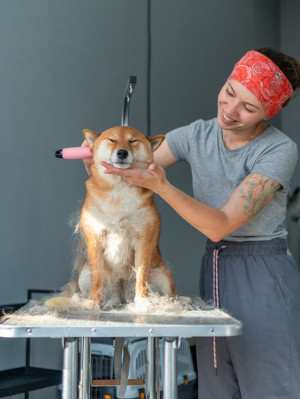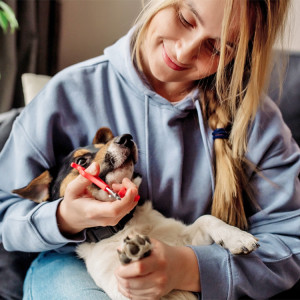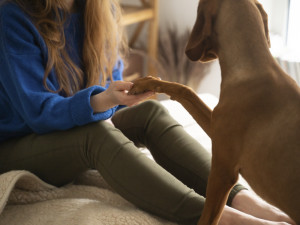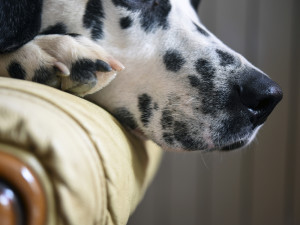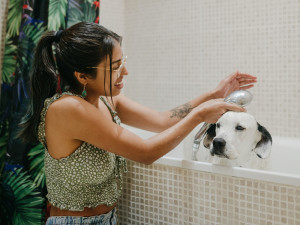How Long Should Dog Nails Be? When to Trim and When to Wait
Cutting your pup’s nails is no walk in the park, but unfortunately it has to be done.
In This Article:
How Long Should Your Dog’s Nails Be? How Often Should You Clip Your Dog’s Nails? How to Tell if Your Dog Needs a Nail-Clipping Tips for Clipping Your Dog’s Nails
Part of grooming your dog is taking proper care of the nails. You don’t want them to be too long. This can lead to overgrown nails that grow into the pad, causing bleeding, pain, and even infection. They can also lead to joint problems and difficulty walking.
On the other hand, if you trim them too short, you can, in the process, cut the quick, causing pain, bleeding, and even infection. Their nails need to be kept at just the right length. How do you know when it’s time to trim? Understanding the right nail length, trimming frequency, and proper techniques will keep your pup comfortable and happy.
How much do you spend on your pet per year?
How long should your dog’s nails be?
One way to gauge the correct length is to have your dog stand on a hard, flat surface. The nails should not touch the ground. Another method is to listen to your dog as they walk across the floor. You should not hear the clicking of their nails. If you do, it’s time for a trim.
Ideally, the nails should be short enough to avoid curling, splitting, or growing into the paw pads, but not so short that you hit the quick (the blood vessel inside the nail). As you trim the nails over time, the quick will recede, allowing you to trim them shorter.
How often should you clip your dog’s nails?
The answer to this question varies from dog to dog, and depends on the following factors:
Your dog’s activity level
Their breed
The surfaces they frequently walk on
For example, active dogs walking on pavement may need nail trims every four to six weeks. Indoor dogs or older dogs who walk on soft surfaces may need their nails trimmed just every two to four weeks. Puppies will need more frequent trimming, since their nails grow faster and are less likely to be worn down naturally. If your dog has dewclaws, these nails don’t touch the ground and won’t wear down on their own, so they will need more frequent trimming.
How to tell if your dog needs a nail clipping
Look for these signs:
Clicking sounds when your dog walks
Obvious curling of the nail tip
Nails touching the ground or pushing sideways when your dog is standing
Trouble walking or limping
Redness, swelling, or broken nails, which could indicate trauma or even infection from overgrowth
Tips for clipping your dog’s nails
Trimming your dog’s nails can be stressful for you and your dog, but it doesn’t have to be. With the right approach and tools, it can be a simple and painless part of their grooming routine.
Slowly introduce the clippers
If your dog has never had nail trims before, get them comfortable with the clippers. Let them sniff and explore the clippers or grinder. Play with their paws, giving them treats and praising them for staying calm. Gradually work up to touching their nails with the clippers without trimming. Some dogs may need this repeated over days or even weeks to keep them from becoming anxious.
Clip a little at a time, and monitor your dog’s comfort
Use sharp, high-quality clippers designed specifically for dogs. Start with small cuts at the very tip of the nail. After each cut, watch for a dark center inside the nail — this indicates you’re approaching the quick. Dogs with light-colored nails are easy, because the pink will be quite visible. Darker nails make it more challenging to see the quick. Take your time and trim only a very small amount at a time.
If your dog flinches, stop and reassess — you may be too close to the quick. Always keep styptic powder or cornstarch nearby in case you accidentally nick the quick and need to stop the bleeding. Styptic powder works best.
Trim on a consistent schedule
Regardless of when a dog’s nails are supposed to be trimmed, check them every two weeks. This will prevent overgrown nails.
You can also file or grind the nails instead of clipping them. This will smooth rough edges and help maintain length between trims. Nail grinders can be especially helpful for dogs who are sensitive to pressure or have thick nails.
Some dogs do best with short, frequent sessions rather than one long trimming. You don’t have to do all four feet in one sitting. You don’t even have to do every nail on one paw at one time. Spreading it out over a few days is perfectly fine.
Bottom line
Part of every proper grooming session includes checking your dog’s nails. If the nails are too long, they can dig into the pads, causing pain, infection, and interfering with a proper gait, ultimately leading to long-term joint problems.
Nails should not touch the ground when your dog is standing still. You should also not be able to hear clicking sounds when your dog walks on a hard floor.
Make the nail-trimming sessions comfortable by using treats, moving slowly, and introducing the tools gradually.
References
Edwards, Petra T., et al. “Puppy Pedicures: Exploring the Experiences of Australian Dogs to Nail Trims.” Applied Animal Behaviour Science, vol. 255, Oct. 2022, p. 105730, doi.org/10.1016/j.applanim.2022.105730opens in new tab.
Mills, Katelyn E., et al. “A Review of Medically Unnecessary Surgeries in Dogs and Cats.” Journal of the American Veterinary Medical Association, vol. 248, no. 2, 15 Jan. 2016, pp. 162–171, avmajournals.avma.org/view/journals/javma/248/2/javma.248.2.162.xmlopens in new tab, doi.org/10.2460/javma.248.2.162opens in new tab.
Salci, Hakan, et al. “Nail Lesions in Dogs and Cats: A Randomized Clinical Study.” Acta Scientiae Veterinariae, vol. 52, 18 Nov. 2024, seer.ufrgs.br/ActaScientiaeVeterinariae/article/view/141509opens in new tab, doi.org/10.22456/1679-9216.141509opens in new tab.



